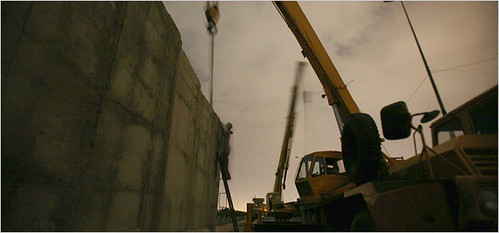Al Quds Street, Sadr City

[Image: U.S. Begins Erecting Wall in Sadr City, New York Times, photo by Joao Silva, 2008.]
Well, you knew it was coming, and it sure didn’t take long. American forces began constructing a new wall in Baghdad last night, in Sadr City where regular skirmishes between US-Iraqi forces and Shiite militias haunt the streets, and reconstruction efforts in the area are routinely hampered by a sad mix of violence and politics, among other factors, to say the least.
According to the New York Times, “The construction, which began Tuesday night, is intended to turn the southern quarter of Sadr City near the international Green Zone into a protected enclave.” American and Iraqi forces say they’ve been battling “Iranian-backed groups and militia fighters who support Moktada al-Sadr, the anti-American cleric. Much of Sadr City has become a sanctuary for such militias.”
Having mentioned these stealth-builder missions before, the Times provides us a glimpse of life-on-the-line laying barrier in the trenches of today’s great concrete footprint of war.
“On Wednesday night, huge cranes slowly lifted heavy concrete blocks into place under a moonless sky. The barriers were implanted on Al Quds Street, a major thoroughfare that separates the Tharwa and Jamilla districts to the south from the heart of Sadr City to the north.
The avenue was quiet except for the whirring sound of the cranes and thud of the barriers as they touched the ground. […]
Al Quds Street has become a porous demarcation line between the American- and Iraqi-protected area to the south and the militia-controlled area to the north.
The avenue has been filled with numerous roadside bombs that American teams in special heavily armored vehicles have sought to clear. The militias have stacked tires on the road and turned them into burning pyres to hamper the American infrared surveillance and targeting systems or to soften the concrete to make it easier to bury bombs. […]
The team building the barrier was protected by M-1 tanks, Stryker vehicles and Apache attack helicopters. As the workers labored in silence, there was a burst of fire as an M-1 tank blasted its main gun at a small group of fighters to the west. An Apache helicopter fired a Hellfire missile at a militia team equipped with rocket-propelled grenades, again interrupting the night with a thunderous boom. A cloud of dark smoke was visible in the distance through the Stryker’s night-vision system."
Since similar walls have gone up in and around Baghdad, officials claim reconstruction efforts and security conditions have improved in these neighborhoods. But I’m always interested how these walls are described to us politically and strategically, as either isolating the militias on the outskirts into cloistered neighborhoods, or as protecting the neighborhoods under threat behind barriers turning them essentially into "protective enclaves" and gated communities. One view is intended to describe an isolation outwards, shutting the militias out, while another describes an isolation inwards, enclosing the communities within. Either way, the wall serves these effects the same, but it is always curious to see how the wall is sold; as a gated community or an insurgent holding pen.
Nevertheless, I understand the short-term effect of these barriers, but we hardly hear enough any discussion from the media or American/Iraqi officials about the long-term effects of using this strategy. Can a nation really be successfully rebuilt behind a micro-insertion of blast walls? I also understand that security needs to be obtained first, but will the walls lead to a more long term systemic security? An eradication of these militias? I seriously doubt that.
Essentially, Baghdad is being reconstructed behind a system of neighborhood dams; or, the warfare equivalent of an urban levee network. But, one wonders, when will we celebrate the stories of the walls coming down? Who knows when or how long that story will ever take in Baghdad to surface, or the West Bank, or anywhere else for that matter, aside from perhaps Cyprus (so there may be hope yet).
More than likely, however, we may be hearing more about the levees being blown apart in these street corners (remember the recent Gaza episode?) than being peacefully and politically deconstructed.
Can a foreign military occupation really fend off an insurgency this way forever? Can a nation truly revive itself with this type of fortress prosthesis, or are these walls more like rebuilding a house of concrete cards?
Also, see: Making Perfunctory Preparations for Combat in Anti-American Cleric’s Stronghold
Iraqi Unit Flees Post, Despite American’s Plea
(Thanks Rob!)







3 Comments:
This is an extremely interesting comment. It's ghetto creation, isn't it? And it looks like after 5 years of war, not even our embassy area of the capital city is secure. I read in Wiki that a dozen nations have 2 or more capital cities owing to war and/or partition. Could violence be reduced if a new administration decided to turn our embassy into a combined hospital - rehab center, offered to facilitate relocation (for willing Baghdadis only) to neighborhoods of co-religionists and then told the Maliki government "you can move to a city of your choice protected by your own forces only, or with us to one of our large isolated bases to be protected by us and where we will build a smaller embassy."
How many lives must be wasted because Bush spent over $.5 billion on an embassy?
In any case, can anyone give me a link to a detailed map of Sadr City showing exactly where the wall on Al Quds street is going up? thanks robert.cogan@gmail.com
what a screwed up situation. And it was all going to be a cakewalk according to dubya and dummy!
Ironic nick names to boot.
and now this:
http://www.telegraph.co.uk/news/worldnews/northamerica/usa/2095230/%27Baghdad-style%27-checkpoints-in-US-capital.html
Post a Comment
<< Home